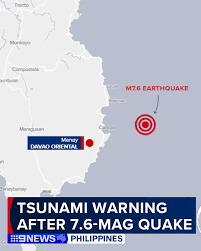Recent Earthquake and Tsunami in the Philippines: What You Need to Know

Introduction
The recent earthquake and tsunami that struck the Philippines have underscored the country’s vulnerability to natural disasters. With its location on the Pacific Ring of Fire, the Philippines frequently experiences seismic activity, making it crucial for residents and authorities to be well-prepared for such events. The significance of this incident not only lies in the immediate impact on affected communities but also in broader implications for disaster management and preparedness in the future.
Details of the Incident
On October 28, 2023, a magnitude 7.1 earthquake hit near the coastal region of Mindanao, triggering a tsunami with waves reaching up to 3 meters. Authorities reported that the earthquake’s epicenter was approximately 60 kilometers off the coast, which raised immediate alarms for coastal cities and towns. Within minutes, tsunami advisories were issued, prompting evacuations along the eastern coastlines.
The Philippine Institute of Volcanology and Seismology (PHIVOLCS) activated its emergency protocols, urging residents to move to higher ground. Local governments quickly mobilised rescue and safety measures, and news reports flooded in detailing the destruction in various areas. As of the latest reports, over 200 people have been confirmed injured, and initial assessments indicate significant structural damage in several towns.
Responses and Preparedness
In the aftermath of the disaster, the Philippine Coast Guard and military forces have been deployed for search and rescue operations. Emergency services are distributing aid to those displaced by the tsunami, while the government assesses the damage. President Ferdinand Marcos Jr. has called for a national emergency meeting to discuss immediate support measures and long-term recovery plans.
Experts emphasise the importance of reinforcing building structures in high-risk areas and improving the public’s awareness of earthquake and tsunami safety protocols. National agencies are expected to review existing disaster response strategies to enhance future preparedness. The government is also working on providing mental health support to those affected, recognising the psychological impact of such traumatic experiences.
Conclusion
The recent earthquake and tsunami incidents serve as a stark reminder of the Philippines’ susceptibility to natural disasters. As communities begin the recovery process, the focus will shift towards rebuilding and enhancing disaster resilience. Authorities aim to implement lessons learned from this event to ensure better safety measures are in place. For residents and stakeholders, staying informed and prepared remains the first line of defence against the unpredictability of nature.
